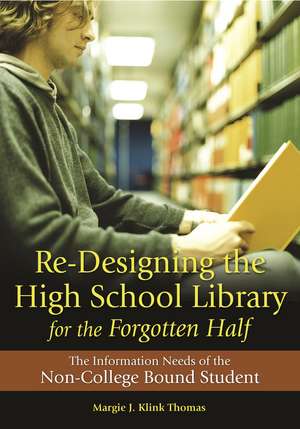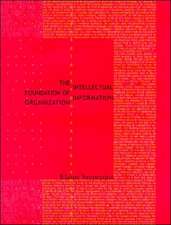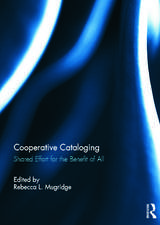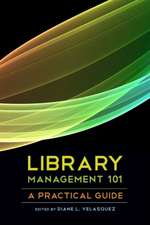Re-Designing the High School Library for the Forgotten Half: The Information Needs of the Non-College Bound Student
Autor Margie J. Klink Thomasen Limba Engleză Paperback – 29 sep 2008 – vârsta până la 17 ani
Preț: 49.69 lei
Nou
Puncte Express: 75
Preț estimativ în valută:
9.51€ • 10.33$ • 7.99£
9.51€ • 10.33$ • 7.99£
Carte disponibilă
Livrare economică 02-16 aprilie
Livrare express 18-22 martie pentru 24.21 lei
Preluare comenzi: 021 569.72.76
Specificații
ISBN-13: 9781591584766
ISBN-10: 1591584760
Pagini: 88
Dimensiuni: 178 x 254 x 8 mm
Greutate: 0.2 kg
Editura: Bloomsbury Publishing
Colecția Libraries Unlimited
Locul publicării:New York, United States
ISBN-10: 1591584760
Pagini: 88
Dimensiuni: 178 x 254 x 8 mm
Greutate: 0.2 kg
Editura: Bloomsbury Publishing
Colecția Libraries Unlimited
Locul publicării:New York, United States
Notă biografică
Margie J. Klink Thomas has been a librarian in special, academic, and public libraries as well as her last position as a high school librarian in Fairbanks, AK. She is a doctoral graduate of Florida State University.
Cuprins
AcknowledgmentsChapter 1: High School Redesign, Restructure and Reform in the 20th CenturyChapter 2: Models for Reform and Re-design: Where's the Library?Chapter 3: Collaborating With the CTE Faculty: Research and ApplicationChapter 4: Exploring the Information Needs of the School-to-Work StudentChapter 5: Information and Technology Literacy AppliedChapter 6: Resources to Meet the Needs of the CTE CurriculumChapter 7: Reaching Out: To Market, To MarketChapter 8: Planning and Organization for the Redesigned High School LibraryIndex
Recenzii
This thoroughly user friendly instructional guide should be a part of every college and university's Library Science reference collection and supplemental reading list.
This book will serve as a valuable resource for those seeking to address the needs of these sometimes-over-looked students.
Thomas strongly advocates involvement by school librarians in the educational reform recommended and currently taking place in many schools across the country. In the first chapter, she examines the history behind educational changes in high schools and libraries during the 20th century and looks at numerous papers, reports, and research results and addresses the role of school libraries in Career Technical Education programs. Emphasis is placed on this relationship and frequently stressed throughout the book and is in response to a lack of background in this area for librarians. Further chapters zero in on some of the reform models being used and promoted, the importance of librarians collaborating with teachers in CTE programs, taking a positive look at meeting the needs of all students and programs, examining the role of the school librarian in school reform measures, and integrating literacy and research skills. The author discusses providing valuable library resources through awareness of program needs, selling the library to all students and faculty, and, finally, taking the steps to investigate and understand these changing needs. Each chapter concludes with an extensive reference list, with Web site addresses for many resources, papers, and programs mentioned. Copious statistics, charts, graphs, figures, etc., support the book's thesis. An invaluable resource and instructional guide.
Any school librarian in a school where a large number of students graduate and move directly into the work place would benefit from the purchase of this comprehensive guide to serving the needs of the 'forgotten half' of the student body.
. . . provides a solid overview for those entering the field and school librarians not already collaborating with all their colleagues.
This book will serve as a valuable resource for those seeking to address the needs of these sometimes-over-looked students.
Thomas strongly advocates involvement by school librarians in the educational reform recommended and currently taking place in many schools across the country. In the first chapter, she examines the history behind educational changes in high schools and libraries during the 20th century and looks at numerous papers, reports, and research results and addresses the role of school libraries in Career Technical Education programs. Emphasis is placed on this relationship and frequently stressed throughout the book and is in response to a lack of background in this area for librarians. Further chapters zero in on some of the reform models being used and promoted, the importance of librarians collaborating with teachers in CTE programs, taking a positive look at meeting the needs of all students and programs, examining the role of the school librarian in school reform measures, and integrating literacy and research skills. The author discusses providing valuable library resources through awareness of program needs, selling the library to all students and faculty, and, finally, taking the steps to investigate and understand these changing needs. Each chapter concludes with an extensive reference list, with Web site addresses for many resources, papers, and programs mentioned. Copious statistics, charts, graphs, figures, etc., support the book's thesis. An invaluable resource and instructional guide.
Any school librarian in a school where a large number of students graduate and move directly into the work place would benefit from the purchase of this comprehensive guide to serving the needs of the 'forgotten half' of the student body.
. . . provides a solid overview for those entering the field and school librarians not already collaborating with all their colleagues.








